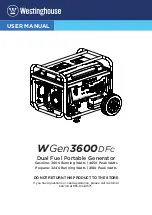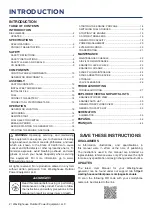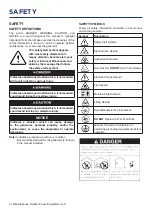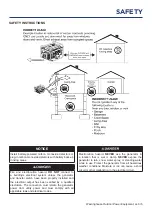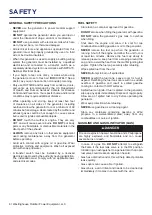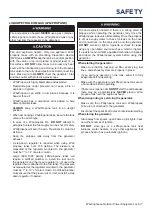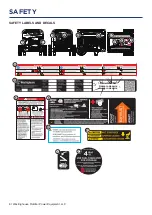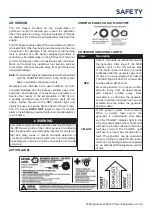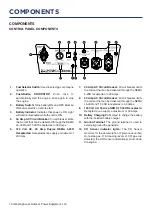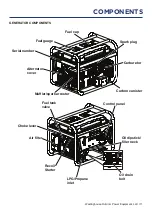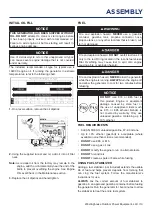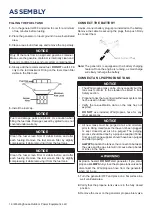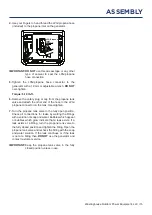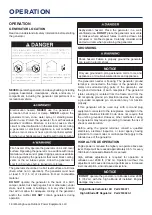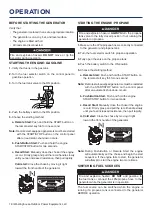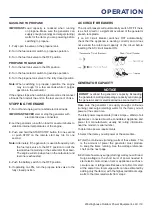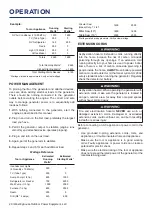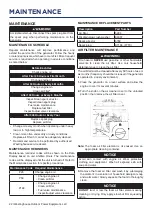
Westinghouse Outdoor Power Equipment, LLC | 7
LIQUID PETROLEUM GAS (LPG/PROPANE)
Fire and explosion hazard.
NEVER
use a gas container,
LPG/propane connector hose, LPG/propane tank or any
other fuel item that appears to be damaged.
Fire and explosion hazard. Only use approved LPG/
propane tanks with an Overfilling Prevention Device
(OPD) valve.
ALWAYS
keep the tank in a vertical position
with the valve on top and placed at ground level on a
flat surface.
DO NOT
allow tanks to be near any
heat
source. When transporting and storing, turn the propane
tank valve to the fully closed position and disconnect the
tank. Make sure to
ALWAYS
cover the generator inlet
and tank outlet with protective plastic caps.
•
LPG/Propane is highly flammable and explosive.
•
Flammable gas under pressure can cause a fire or
explosion if ignited.
• LPG/Propane can settle in low places because it is
heavier than air.
• LPG/Propane has a distinctive odor added to help
detect potential leaks.
•
ALWAYS
keep a LPG/Propane tank in an upright
position.
• When exchanging LPG/propane tanks, be sure the tank
valve is the same type.
•
In case of a LPG/propane fire,
DO NOT
attempt to
extinguish unless the fuel supply can be shut off safely.
• LPG/propane will burn the skin. Prevent skin contact at
all times.
• Keep the propane tank away from the generator
exhaust.
• A step-down regulator is required when using LPG/
propane tanks over 100 gallons. The pressure as
measured at the regulator mounted to the generator
must be 7” to 14” of water column.
• Large (500–1000 gallon) LPG/propane tanks will
require a certified plumber to install the fuel line to
the generator and the loose regulator is not used (the
regulator that is attached to the fuel tank). The pressure
as measured at the regulator mounted to the generator
must be 7” to 14” of water column. A certified plumber
must ensure that the pressure is correct or install a step
down regulator if needed.
Fire and explosion hazard. If there is a strong smell of
propane while operating the generator, fully close the
LPG/propane tank valve immediately. Once the propane
is off, use soapy water to check for leaks on the hose
and connections on the tank valve and the generator.
DO NOT
smoke or light a cigarette or check for leaks
using any open flame source such as a match or lighter.
If a leak is found, contact a qualified technician to inspect
and repair the LPG/propane system before using the
generator.
When starting the generator:
•
Make sure that the fuel cap, air filter, spark plug, fuel
lines, and exhaust system are properly in place.
• If you spill any gasoline on the tank, allow it to fully
evaporate before operating.
• Make sure the generator and LPG/propane tank are on
a flat surface before operating.
• If there is a propane odor
DO NOT
start the unit because
there may be a potential leak.
NEVER
place a LPG/
propane tank near the engine exhaust.
When transporting or servicing the generator:
• Make sure the LPG/propane tank and LPG/propane
hose are not attached to the generator.
• Disconnect the spark boot to prevent accidental starting.
When storing the generator:
•
Store away from sparks, open flames, pilot lights, heat,
and other sources of ignition.
•
DO NOT
store gas or a LPG/propane tank near
furnaces, water heaters, or any other appliances that
produce heat or have automatic ignitions.
SAFETY

